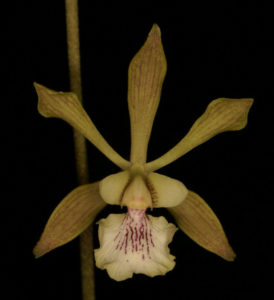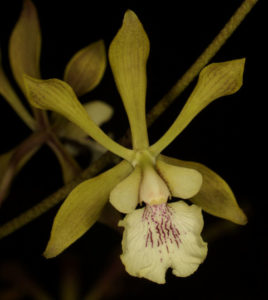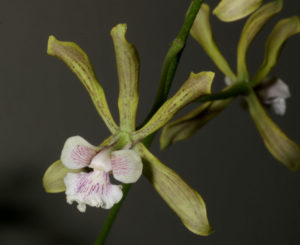The following article was written for the Orchid Species Bulletin published by the Orchid Species Society, which is based in Brisbane, Queensland in February 2011.
Bear in mind that any cultivation notes refer to the subtropical conditions of Southern Queensland, Australia.

Encyclia belizensis (Rchb.f.) Schltr. has a much confused history, particularly as different authors have interpreted the type differently!
According to Robert Dressler and Glenn Pollard (1976), Heinrich Gustav Reichenbach first described this species as Epidendrum belizense in Linnaea. Ein Journal für de Botanik in Ihram Ganzen Umfange in 1876. The specific epithet comes from Belize and the Latin suffix –ense (place, origin) for where the type specimen was collected. Rudolf Schlechter transferred this taxon to Encyclia in Beihefte zum Botanischen Centralblatt in 1918. Dressler and Pollard at one stage reduced this species to E. alata subsp. virella in Phytologia in 1971. The authors, however, did not stay with that reduction in 1976.
Unfortunately the confusion arises because Carl Withner (1998) points out that Enc. belizensis should be known by the earlier name Enc. guatemalensis (Klotzsch) Dressler & G.E.Pollard. Withner cites the tracings by Leslie Garay of the flowers of the type for both Enc. guatemalensis and Enc. belizensis as being the same. In addition, Withner believes that the species that Dressler and Pollard recognise as Enc. guatemalensis, which bears panicles of small glossy, mostly maroon to dark reddish brown flowers that have a white lip streaked with red-brown or purple, should be called Enc. dickinsoniana (Withner) Hamer.
 I now follow recent authors such as Joyce Stewart and Mark Griffiths (1995), Ian McLeish et al. (1995) and Eric Hágsater et al. (2005) who maintain Enc. belizensis and Enc. guatemalensis as separate taxa.
I now follow recent authors such as Joyce Stewart and Mark Griffiths (1995), Ian McLeish et al. (1995) and Eric Hágsater et al. (2005) who maintain Enc. belizensis and Enc. guatemalensis as separate taxa.
Enc. belizensis has clustered conic-ovoid shiny pseudobulbs that are 3-4.5 cm long and 1.2-2 cm broad. At the apex of each pseudobulb are two (sometimes three) narrowly elliptic-lanceolate to nearly linear leaves that are 9-50 cm long and 1-2 cm broad. Its pseudobulbs vary from green to purple-brown and the leaves may be dark green or purplish. Simple racemose inflorescences, which may be sometimes few-branched, are produced from the apex of the pseudobulbs from late spring to summer. They are commonly erect and are 40-90 cm long bearing few to many flowers. The flowers are usually scentless but some cultivars may be fragrant.
The flowers of Enc. belizensis are 3-4 cm across and are variable in colour. Yellow-green to olive green, the sepals and petals are often variably streaked with brown particularly towards the tips. Its lip is cream to pale yellow with the bases of the side-lobes and centre of the mid-lobe streaked with red-brown to purple along the veins that are raised and minutely warty. The winged column is greenish white, usually streaked with purple. The flowers last for up to 5 weeks in bloom.
Recognition of Enc. belizensis is by the green or greenish flowers, the winged column and the minutely warty lip. In addition, the oblong lip side-lobes are about the same width from the base to the apex. They are veined only at the base and have clear white tips, which reflex back on each side of the column apex.

Enc. belizensis is distributed from Belize, Guatemala, Honduras and Mexico, with an unconfirmed report from Nicaragua. It is found growing in open rocky outcrops, on the ground or on trees or shrubs usually in dry, scrubby oak or semi-deciduous forest between 100-1,300 m altitude.
Grow Enc. belizensis in a coarse or well drained medium and provide it with regular water during the warmer months when it is actively growing. The roots of Encyclias prefer to dry quickly between watering and will resent being continually wet. Provide it with bright light such as 60-70% shade and a drier winter rest period. During the rest period, ensure that the roots are allowed to dry briefly between watering. I recommend a winter minimum of 12 oC with the plant kept dry at night during the cooler months.
